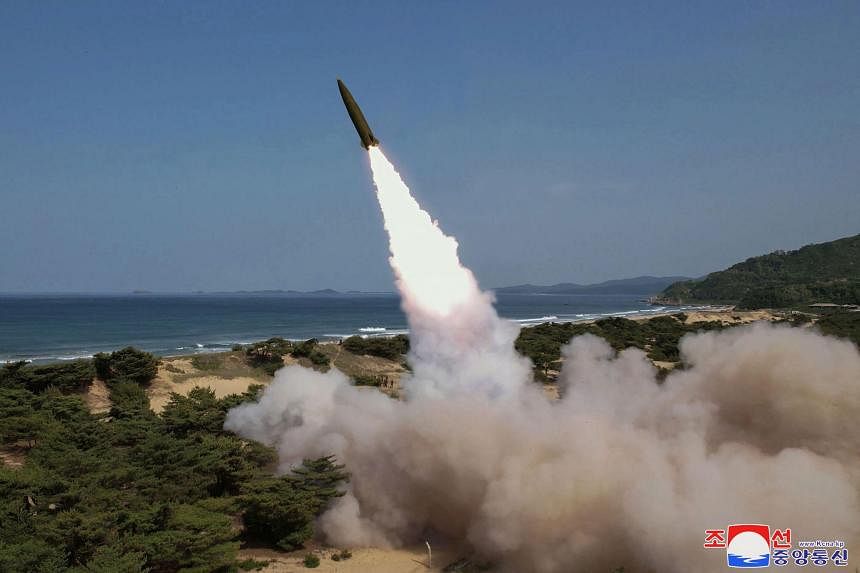
SEOUL – North Korea said its attempt to launch a new military reconnaissance satellite ended in failure on May 27 when a newly developed rocket engine exploded in flight.
The attempt came just hours after Pyongyang issued a warning that it would try to launch a satellite by June 4, in what would have been its second spy satellite in orbit.
Instead, the launch became the nuclear-armed North’s latest failure, following two other fiery crashes in 2023. It successfully placed its first spy satellite in orbit in November.
“The launch of the new satellite carrier rocket failed when it exploded in mid-air during the flight of the first stage,” the deputy director-general of North Korea’s National Aerospace Technology Administration said in a report carried by state media.
An initial analysis suggested that the cause was a newly developed liquid fuel rocket motor, but other possible causes were being investigated, the report said.
Officials in South Korea and Japan had earlier reported that the launch seemed to have failed.
North Korea fired the projectile on a southern path off its west coast at around 10.44pm (9.44pm in Singapore), the South’s Joint Chiefs of Staff (JCS) said, hours after Pyongyang said it would be launching a satellite some time before June 4.
JCS said it detected debris from the rocket in the sea, however, and South Korean and US intelligence agencies were investigating whether the launch failed.
The object launched by North Korea disappeared over the Yellow Sea, Japanese Chief Cabinet Secretary Yoshimasa Hayashi told reporters, adding the government presumes nothing had entered the space.
“These launches are in violation of relevant security council resolutions and are a serious matter concerning the safety of our people,” Mr Hayashi said.
Japanese public broadcaster NHK showed video of what appeared to be an orange dot flying into the night sky and then bursting into flames in an area close to the border between China and North Korea.
A Japanese Defence Ministry official told reporters that the colour of the flames in the footage suggests that liquid fuel may be burning, but details are currently being analysed, NHK reported.
The launch appeared to originate from Dongchang-ri, a north-western area of the country where North Korea’s main space flight centre is based, the South’s Joint Chiefs of Staff said.
The Japanese government issued an emergency warning for residents in the south to take cover from the possible threat of a North Korean missile. It later lifted the warning, saying the missile was not expected to fly over Japanese territory.
Japan said over its J-Alert broadcasting system that North Korea appeared to have fired a missile, sending out the warning to residents in the southern prefecture of Okinawa.
Several failure, one sucess
The launch would likely be the nuclear-armed North’s attempt to place a second spy satellite into orbit. After several failed attempts that ended when the rockets crashed, North Korea successfully placed its first such satellite in orbit in November.
The North’s first bid to launch the new Chollima-1 satellite rocket, on May 31, 2023, ended after a failure in the second stage. State media blamed the setback on an unstable and unreliable new engine system and fuel.
After the May launch attempt, South Korea retrieved the wreckage of the satellite from the sea and said an analysis showed it had no meaningful use as a reconnaissance platform.
Another attempt in August also ended in failure, with stages of the rocket boosters experiencing problems resulting in the payloads crashing into the sea.
North Korea’s space authorities described the August failure after the rocket booster experienced a problem with its third stage as “not a big issue” in terms of the rocket system’s overall reliability.
In February, US space experts said North Korea’s first spy satellite, dubbed the Malligyong-1, was “alive”, after detecting changes in its orbit that suggested Pyongyang was successfully controlling the spacecraft, although its capabilities remain unknown.
North Korean state media reported that the satellite transmitted photos of the Pentagon and the White House, among other areas, but has not released any of the images.
The successful November launch was the first after North Korean leader Kim Jong Un made a rare trip abroad in September and toured Russia’s most modern space launch centre, where President Vladimir Putin promised to help Pyongyang build satellites.
Neither country has elaborated on the extent of that future aid, which could violate United Nations Security Council resolutions against North Korea.
Russian experts have visited North Korea to help with the satellite and space rocket programme, South Korea’s Yonhap news agency reported, citing an unnamed South Korean senior defence official.
Pyongyang has said it needs a military reconnaissance satellite to boost monitoring of US and South Korean military activities. REUTERS
https://news.google.com/rss/articles/CBMiZmh0dHBzOi8vd3d3LnN0cmFpdHN0aW1lcy5jb20vYXNpYS9ub3J0aC1rb3JlYS1maXJlcy1zdXNwZWN0ZWQtcm9ja2V0LWFmdGVyLXdhcm5pbmctb2Ytc2F0ZWxsaXRlLWxhdW5jaNIBAA?oc=5
2024-05-27 14:27:25Z
CBMiZmh0dHBzOi8vd3d3LnN0cmFpdHN0aW1lcy5jb20vYXNpYS9ub3J0aC1rb3JlYS1maXJlcy1zdXNwZWN0ZWQtcm9ja2V0LWFmdGVyLXdhcm5pbmctb2Ytc2F0ZWxsaXRlLWxhdW5jaNIBAA
Tidak ada komentar:
Posting Komentar